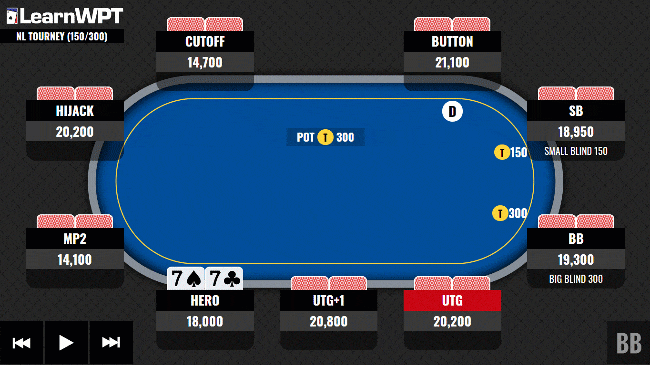Set of Sevens vs a Check-Raise, what do you do here?

DECISION POINT: In a Tournament with 150/300 blinds it folds to you in Middle Position holding 7♠7♣ and you raise to 800. Action folds around to the Big Blind who calls. The flop comes 7♥A♠8♣ and BB checks. You bet 600 and your opponent calls. The BB checks the T♥ turn and you bet 2,000. Your opponent raises to 7,000 and action is on you. What do you do here?
PRO ANSWER: In a Multi-table Tournament with 150/300 blinds we are dealt pocket sevens in MP1. It folds to us and we make a standard raise to 800. Action folds to the Big Blind who flat calls and we see a flop.
The flop is 7hAs8c. We flopped a set with a stack to pot ratio (SPR) of 8.5 and our opponent checks to us. While it can be tempting to slowplay, this is a spot where we have a significant range advantage. We also want to c-bet bluff a fair amount with other parts of our range, and stacks are deep enough that money needs to go in on all three streets for us to have an opportunity to get all of the chips in. While it is never fun to flop a huge hand and have our opponents fold to our continuation bet, the situation is very favorable for c-betting and we should avoid the urge to slow play here.
Given our massive range advantage in this spot and the relative dryness of the board a c-bet in the neighborhood of a ⅓ bet sizing is appropriate. While the 8 and the 7 are connected and hands like T9s/65s are a part of our opponent’s range, they are a relatively small part while hands like A5s/99 make up a much larger portion. We elect to make it 600 and our opponent calls.
The turn is the Th. While our opponent does potentially have some TT in their range, as long as our range assessment is correct are ahead on the flop in this spot it is quite unlikely we are behind now. If our opponent were making lose calls preflop 96s may be in their range, however most players most likely have J9s here as part of a check-raising range rather than a check/calling range.
Most of the points from the flop remain true here. We still hold a significant range advantage and it is still difficult for us to win a big pot without betting again here. There is no reason to slow down considering any 6, 9, or J could be scare cards on the river both for potentially killing our action and allowing our opponent to make a better hand. We elect to bet 2,000 and our opponent check-raises to 7,000.
Continued below...
At this point our opponent could have slowplayed 88, turned a set with TT, or occasionally turn a straight with with 96s. They could also have hands like A7s/A8s/ATs/ATo or be semi-bluffing hands like A9s/AJs/AJo/T9s/98s. Our hand is too strong to really consider folding as an option. If we operate under the assumption that our opponent will never fold the 2-pair+ hands in their range if we move all-in here we will have over 56% equity when called (assuming they only have 96s 50% of the time here).
If we keep semi-bluffs in their range our equity jumps to over 71%. The downside is that since almost all of our opponent's reasonable semi-bluffing hands have a pair in them they are unlikely to turn all, or even half of them, into semi-bluffs. Since those semi-bluffing combos in their range have some equity on all possible river cards it becomes less likely that Villain will continue to bluff with this part of their range the river when we flat call, as most of those hands would be content to take a cheap showdown.
Given that calling won’t make it that much more likely that our opponent continues any of their bluffs on the river, we are likely to have significant equity versus even the stronger parts of their range. The fact that we lose on many river cards against hands like AT that would likely get all-in on the turn but slow down if a 9 or a J fell on the river, makes it logical for us to get the rest of the chips in now for value.
Moving all-in is the best play.
What would you do here?
Share your answer in the comments below!
What Leak Will You Plug
During Lab Day?
Ever wish you had a Poker Pro looking over your shoulder, helping you to decide whether to call a big raise or fire that third barrel?
What if you had the chance to get personal advice and feedback on YOUR play from Nick Binger, Andrew "LuckyChewy" Lichtenberger, and Eric "Rizen" Lynch?
Attend the LearnWPT Live at Bellagio Tournament Strategy Workshop + Lab Day Session this May 23rd - 25th in Las Vegas and:
- Transform your preflop and postflop play through a deeper understanding of concepts and strategies used by top players
- Discover the process that the world’s best players use to maintain a cycle of constant improvement and keep their edge
- Get in-depth feedback regarding your play and learn the keys to real-time hand analysis directly at the table during Lab Day
- Seize the opportunity to be 1 of 30 students who are given intimate access to proven advanced techniques and processes
Questions? Contact the Live Support Team at (888) 600-5593 or [email protected] and we’ll be happy to help.
